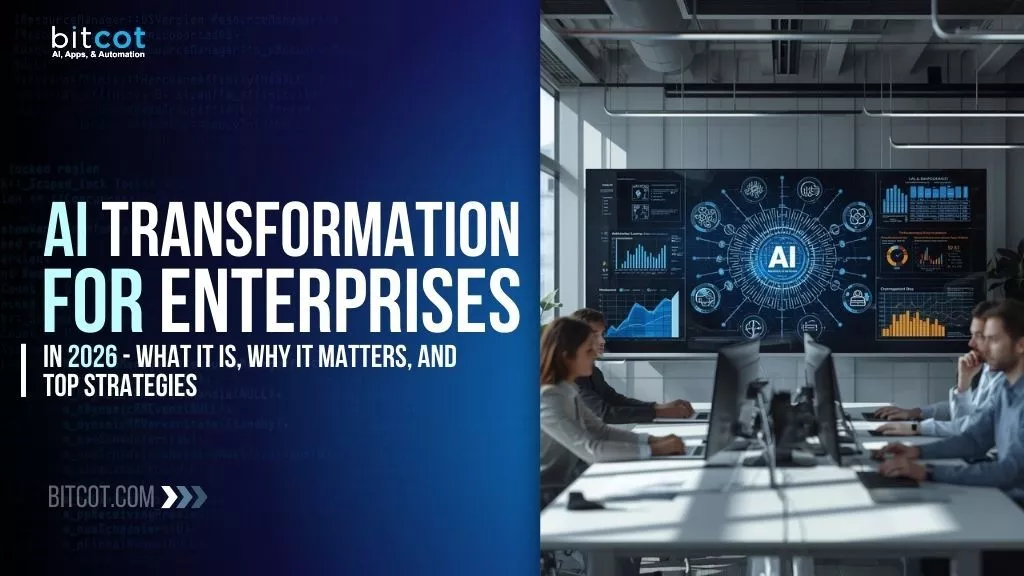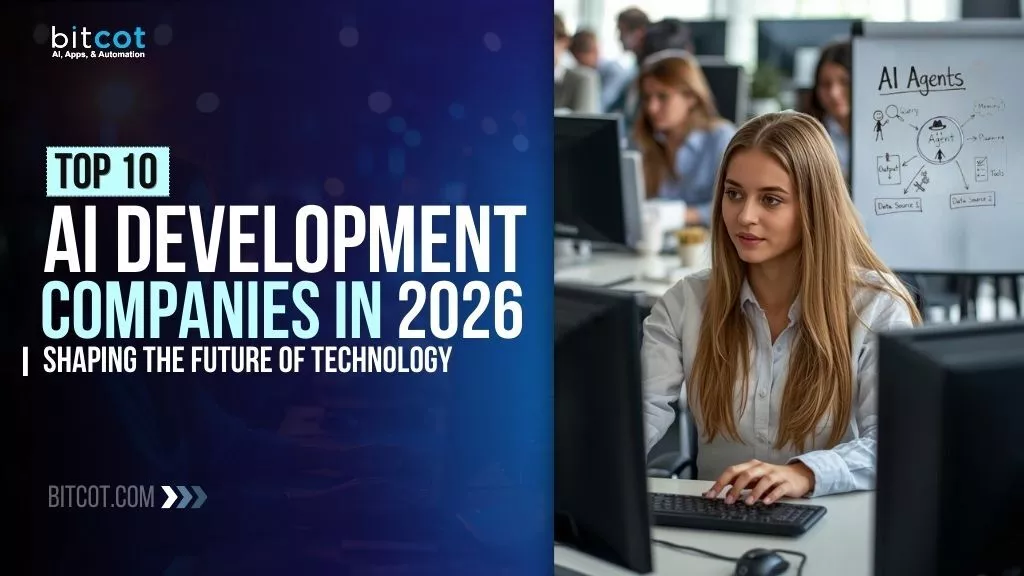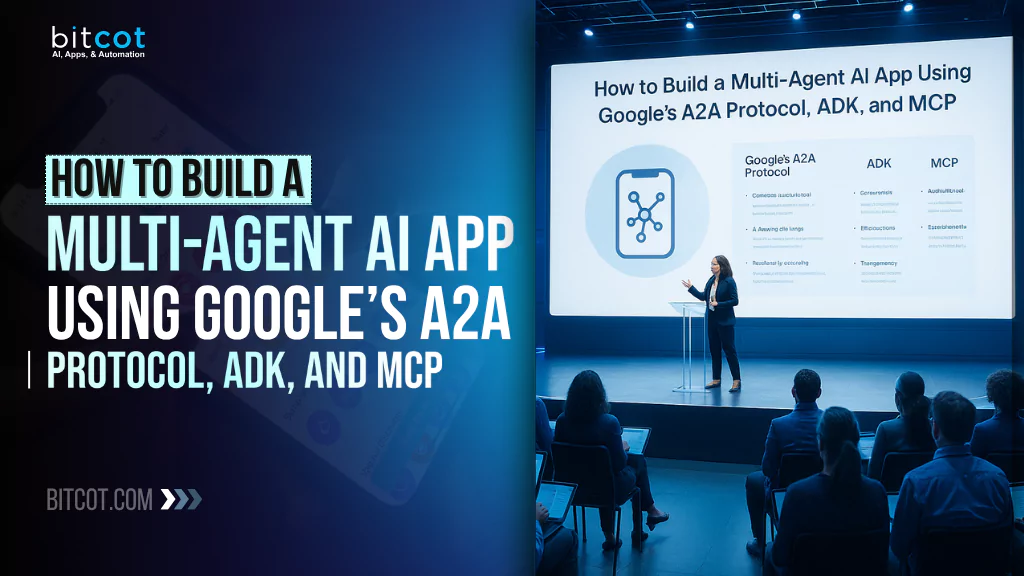
AI is no longer just about smart assistants or large language models answering questions. The next wave of innovation lies in building systems where multiple AI agents, each with a specific role, can work together, much like a team.
This approach, known as multi-agent architecture, is changing how businesses design intelligent applications.
Imagine a customer onboarding process that doesn’t rely on a single model trying to do it all. Instead, one AI agent verifies documents, another interprets the customer’s needs, a third recommends suitable products, and yet another handles compliance, all in real time, communicating with each other to move the process forward without human intervention.
This isn’t science fiction. With the right tools, it’s something your business can implement today.
In this article, we’ll explore how to build a multi-agent AI application using three foundational components:
- A2A Protocol: the communication standard that lets AI agents talk to each other clearly and securely
- ADK (Agent Development Kit): the framework for designing and deploying agents with defined roles
- MCP (Model Context Protocol): the open standard that connects AI assistants to external systems, data sources, and tools
Whether you’re looking to scale customer support, automate internal workflows, or create AI-driven decision-making systems, this guide will show you how multi-agent AI can unlock new levels of performance, agility, and intelligence.
Let’s dive in.
What are Multi-Agent Systems in Artificial Intelligence?
A multi-agent system consists of several autonomous AI agents that independently perceive their environment, make decisions, and interact with other agents to achieve individual or shared business goals.
Unlike traditional AI models that operate in isolation, multi-agent systems distribute intelligence across specialized agents, creating a dynamic and flexible network capable of solving complex problems through cooperation and communication.
Each agent acts as an independent entity with a specific role or expertise, similar to how departments or teams function in an organization. This decentralized approach allows businesses to tackle multifaceted challenges by breaking them down into manageable, coordinated tasks.
Also Read: How to Build an AI System in 7 Steps – Your 2025 Roadmap
Building and managing a successful multi-agent AI system requires more than just independent agents; it demands a robust framework that supports agent communication, development, and orchestration.
This is where the A2A, ADK, and MCP come into play.
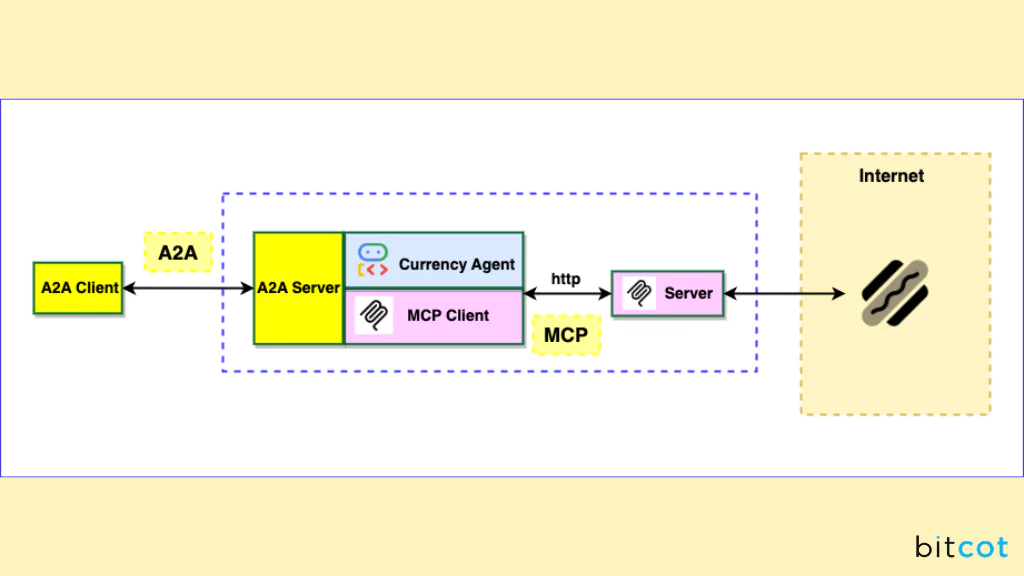 Source: Google Codelabs, 2025
Source: Google Codelabs, 2025
Together, they form the backbone of a powerful multi-agent AI architecture. They enable businesses to build scalable, flexible, and resilient AI systems where multiple agents collaborate intelligently, driving innovation, enhancing automation, and delivering measurable business value.
A2A Protocol (Agent-to-Agent Protocol)
Google’s Agent-to-Agent (A2A) Protocol serves as the communication backbone for multi-agent systems.
This protocol enables:
- Standardized Communication: Agents can exchange information, requests, and responses using a common language structure, regardless of their underlying implementation or specialization.
- Task Coordination: The protocol manages how agents distribute work, share resources, and coordinate their activities to achieve common goals.
- Context Preservation: Critical business context and conversation history are maintained across agent interactions, ensuring continuity in complex workflows.
- Scalable Architecture: As your business grows, new agents can be added to the system without disrupting existing operations.
Agent Development Kit (ADK)
The Agent Development Kit (ADK) provides the tools and frameworks necessary to create, deploy, and manage AI agents within the A2A ecosystem.
Key components include:
- Agent Templates: Pre-built frameworks for common business use cases like customer support, sales assistance, and data analysis agents.
- Integration APIs: Seamless connections to existing business systems, databases, and third-party services.
- Monitoring and Analytics: Real-time insights into agent performance, interaction patterns, and business impact metrics.
- Security Framework: Enterprise-grade security features including authentication, authorization, and data encryption.
Model Context Protocol (MCP)
Anthropic’s MCP (Model Context Protocol) ensures that AI agents maintain relevant context throughout complex multi-step processes. Building AI agents using MCP is crucial for business applications where decisions depend on historical data, user preferences, and ongoing project requirements. Key features include:
- Context Sharing: Enables agents to share relevant information and maintain conversational continuity across different specialized agents in the network.
- Memory Management: Efficiently stores and retrieves contextual information, preventing agents from losing track of important details during extended interactions.
- State Synchronization: Ensures all agents in the system have access to the most current information about ongoing processes and user interactions.
- Privacy Controls: Implements granular permissions to control which context information is shared between different agents, maintaining data security and compliance requirements.
Benefits of Multi-Agent Systems for Businesses
Implementing multi-agent systems using technologies like the A2A, ADK, and MCP delivers significant business advantages beyond technical improvements.
Here’s how multi-agent systems drive meaningful outcomes that matter most to businesses:
1. Accelerated Decision-Making Across Teams
Multi-agent systems empower AI agents to collaborate and share insights in real time, enabling faster and more informed decisions across departments. This agility helps businesses respond quickly to market changes, customer needs, and operational challenges, improving competitiveness and reducing time to market.
2. Increased Operational Efficiency and Automation
By distributing tasks intelligently among specialized agents, multi-agent systems automate complex workflows that traditionally require human coordination. This reduces manual errors, speeds up repetitive processes, and frees up employee time for higher-value work, leading to cost savings and improved productivity.
3. Enhanced Customer Experience
Multi-agent AI applications can deliver personalized, seamless interactions by combining multiple capabilities such as natural language understanding, sentiment analysis, and proactive support. This results in faster resolutions, tailored recommendations, and higher customer satisfaction and loyalty.
4. Improved Risk Management and Compliance
Multi-agent systems enable continuous monitoring and coordination among agents focused on regulatory requirements, fraud detection, and operational risks. The distributed intelligence and shared context ensure businesses stay compliant with evolving regulations and identify risks early, reducing costly penalties and reputational damage.
Also Read: How to Use OpenAI’s AI Agent Tools for Building AI Agents in 2025
5. Greater Business Agility and Innovation
Because agents can be independently developed and deployed using ADK and coordinated via A2A and MCP, businesses gain the flexibility to experiment and innovate rapidly. This modular approach supports quick adaptation to new opportunities, competitive pressures, or disruptions without overhauling entire systems.
6. Scalable Growth Without Disruption
Multi-agent systems grow organically by adding new agents or enhancing existing ones, supporting business expansion and diversification. Unlike monolithic AI solutions, multi-agent systems avoid bottlenecks and downtime, enabling smooth scaling while maintaining continuous service delivery.
7. Cost-Effective AI Adoption
By focusing on specialized agents and orchestrated collaboration, businesses avoid investing heavily in all-encompassing AI models. This targeted approach lowers development and maintenance costs, delivering a faster return on investment while enabling progressive AI adoption.
8. Cross-Departmental Collaboration
Multi-agent systems break down silos by allowing AI agents representing different business units or functions to collaborate effectively. This interconnected intelligence promotes unified strategies, better data sharing, and improved alignment toward overall business goals.
Use Cases for Multi-Agent Systems in Business
Multi-agent systems powered by A2A, ADK, and MCP are revolutionizing how businesses operate by enabling intelligent, collaborative AI that addresses complex challenges.
| Use Case | How It Works | Business Value |
| Workflow Automation | Agents handle steps like data entry, validation, and reporting with shared goals. | Faster processes, fewer errors, less manual work. |
| Smart Resource Allocation | Agents adjust schedules, assets, or staff in real-time. | Better utilization, reduced delays, increased agility. |
| Automated Issue Resolution | Agents detect, classify, and respond to problems before escalation. | Quicker fixes, less downtime, improved reliability. |
| Seamless User Interactions | Agents manage onboarding, support, and follow-ups without losing context. | Smoother experiences, higher satisfaction. |
| Decision Support | Agents gather and summarize insights from multiple data sources. | Smarter decisions, faster responses. |
| Policy Enforcement | Agents check actions against rules and flag or correct issues. | Better compliance, fewer violations, real-time checks. |
Here are some specific use cases where multi-agent systems deliver tangible value across industries:
1. Customer Support and Service Automation
In customer service, multi-agent systems enable different AI agents to handle various parts of the customer journey simultaneously:
- One agent manages initial chat interactions and natural language understanding.
- Another performs sentiment analysis to detect customer emotions.
- A third agent escalates issues to human agents or specialized teams when needed.
This layered approach results in faster response times, personalized experiences, and reduced support costs.
2. Supply Chain and Logistics Optimization
Supply chains are complex, involving many moving parts. Multi-agent systems can coordinate:
- Inventory monitoring agents tracking stock levels in real time.
- Logistics agents optimizing delivery routes based on traffic and weather data.
- Vendor negotiation agents automating procurement communications.
Together, these agents improve efficiency, reduce delays, and minimize operational costs.
3. Financial Services and Fraud Detection
Banks and financial institutions use multi-agent systems to monitor transactions with specialized agents:
- Fraud detection agents analyze patterns and flag suspicious activities.
- Compliance agents ensure transactions meet regulatory requirements.
- Customer onboarding agents streamline identity verification and risk assessments.
The distributed intelligence enables faster detection of anomalies while maintaining regulatory compliance.
4. Healthcare and Patient Management
In healthcare, multi-agent systems help manage complex workflows and patient data:
- Scheduling agents coordinate appointments and resource availability.
- Medical record agents ensure accurate, up-to-date patient histories.
- Diagnostic agents assist clinicians by aggregating data and suggesting possible diagnoses.
These coordinated agents help improve patient outcomes and reduce administrative burden.
Also Read: How AI Agents Are Improving EHR/EMR Systems in Healthcare
5. Smart Manufacturing and Industry 4.0
Manufacturing plants deploy multi-agent systems to monitor equipment health, manage production schedules, and optimize energy consumption:
- Predictive maintenance agents analyze sensor data to prevent downtime.
- Quality control agents inspect products via image recognition.
- Supply management agents synchronize raw material orders.
The result is increased productivity, reduced waste, and cost savings.
6. Retail and Personalized Marketing
Retailers use multi-agent AI to deliver tailored shopping experiences:
- Recommendation agents analyze browsing and purchase history.
- Pricing agents adjust prices dynamically based on demand and inventory.
- Customer feedback agents monitor social media and review sites for sentiment.
This multi-agent collaboration drives higher conversion rates and customer loyalty.
7. Enterprise Workflow Automation
Multi-agent systems can orchestrate complex internal workflows:
- HR agents handle recruitment and onboarding.
- IT support agents automate routine help desk tasks.
- Finance agents manage invoice processing and budgeting.
By automating these processes, companies reduce errors and improve operational speed.
How to Build a Multi-Agent AI App Using A2A, ADK, and MCP
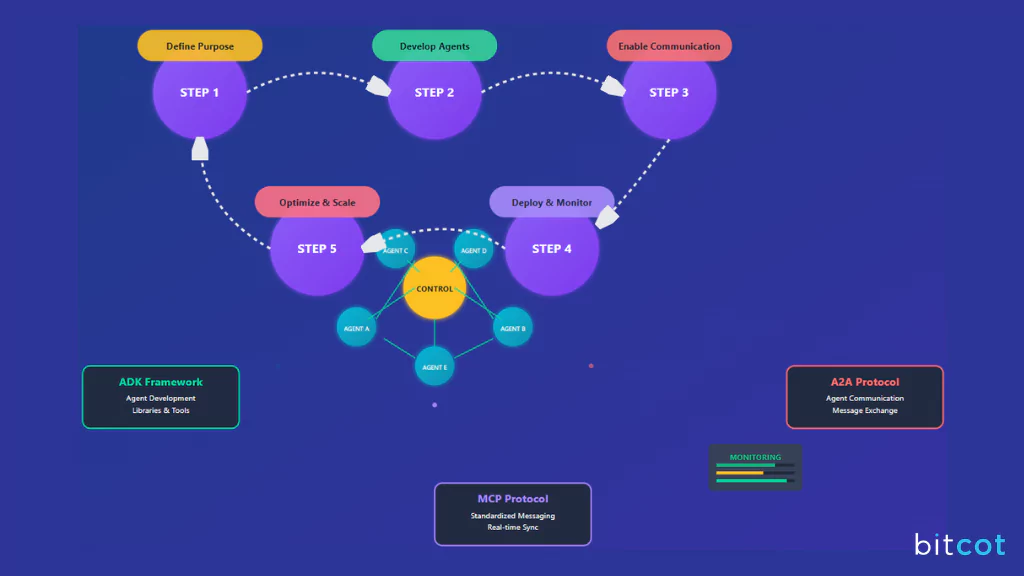
Building a multi-agent AI app using A2A, ADK, and MCP involves several key stages, from defining your agents to deploying the application. Below is a step-by-step approach tailored for business leaders and developers:
Step 1: Define the Purpose of Your Multi-Agent System
The first step in building a multi-agent AI system is defining its objectives. What business problem are you solving? Are you aiming to automate customer service, optimize logistics, or improve decision-making in operations? Your application’s goals will dictate the design of your agents, how they communicate, and how they will work together to achieve these goals.
- Business Use Cases: Identify use cases such as predictive maintenance, automated customer support, dynamic pricing, or supply chain optimization, which would benefit from a multi-agent approach.
- Types of Agents: Define the roles and responsibilities of each agent. For instance, in a supply chain optimization system, you may have agents responsible for inventory management, shipping, and demand forecasting.
Step 2: Develop Your Agents Using the ADK
Once you have a clear vision of your app’s objectives, the next step is to develop the individual agents. The ADK (Agent Development Kit) offers a comprehensive framework to help you design intelligent agents capable of performing specific tasks within the app.
- Use Libraries and Frameworks: Leverage ADK’s built-in libraries to develop agents that can process data, learn from experience, and make decisions autonomously.
- Define Agent Behaviors: Program each agent’s behavior using ADK’s decision-making models. For example, in a customer service app, an agent might use natural language processing (NLP) to understand customer queries and make contextually appropriate responses.
- Testing and Iteration: ADK offers debugging tools and simulators to test the agents in different environments before deployment. It’s crucial to ensure that agents are performing optimally and making reliable decisions.
Step 3: Enable Communication Using A2A Protocol and MCP
Once the agents are built, the next critical step is enabling communication. For effective coordination and collaboration among agents, you must implement the A2A Protocol and MCP.
- Integrate A2A Protocol: With the A2A protocol, agents can exchange data, instructions, and outcomes with each other. A shipment agent might communicate with an inventory agent to update stock levels, or a marketing agent may request data from a customer sentiment analysis agent.
- Use MCP for Standardized Messaging: The MCP ensures all agents speak the same language. This step involves defining message types and formats, ensuring agents can interact seamlessly regardless of their individual development environments or tasks.
- Synchronization: The MCP synchronizes interactions, ensuring that agents receive and process information in real time, optimizing decision-making and collaboration. This becomes especially important when dealing with complex workflows or time-sensitive tasks.
Step 4: Deploy and Monitor the System
With the agents developed and their communication protocol in place, the next step is to deploy the multi-agent AI app.
- Deployment: Deploy the agents on your cloud infrastructure or edge devices, ensuring that they are scalable and can handle a high volume of interactions. Ensure redundancy and fault tolerance are in place to avoid system failure.
- Monitor Performance: Use monitoring tools to track the performance of each agent in real-time. This is crucial for ensuring that agents are operating efficiently and achieving business goals. Monitoring also helps to identify potential bottlenecks or inefficiencies that could be optimized.
Step 5: Optimize and Scale
Once deployed, the final step is to continuously optimize the system and scale it as needed.
- Continuous Learning: Incorporate machine learning algorithms into your agents to improve their decision-making over time. As agents interact with more data and scenarios, they will become more efficient.
- Scalability: As your business grows, your multi-agent system should be able to scale effortlessly. Ensure that your system’s architecture can accommodate additional agents or handle increased workload without performance degradation.
- User Feedback: Gather feedback from users interacting with the system to identify areas of improvement. For example, in customer support applications, feedback from customers can help fine-tune agent responses and interaction patterns.
Building a multi-agent AI application using A2A, ADK, and MCP is an effective approach for businesses looking to harness the power of automation, intelligence, and decentralized decision-making.
Also Read: How to Build AI Agents Using MCP – A Complete Guide for 2025
By following a clear methodology and focusing on seamless communication and scalable development, businesses can create intelligent, self-sustaining systems that optimize operations, improve customer experiences, and drive innovation.
Why Partner with Bitcot to Build Your Multi-Agent AI App
Successfully launching a multi-agent AI application requires more than just coding skills; it demands a strategic partner who understands AI architecture, business outcomes, and seamless user experience. Bitcot brings together the technical depth, domain expertise, and agile execution model needed to transform your vision into a fully operational, intelligent AI ecosystem.
Here’s why leading businesses choose Bitcot to design, build, and scale their multi-agent AI systems:
Deep Expertise in Multi-Agent AI Systems
Bitcot’s AI team has hands-on experience building intelligent systems that simulate real-world collaboration using multiple AI agents. We’ve developed solutions where agents perform specialized tasks, communicating in real time, making independent decisions, and adapting to new inputs.
We don’t just understand the theory; we’ve implemented agent networks for complex domains such as e-commerce, logistics, customer support automation, fintech operations, and intelligent CRM.
Specialized Knowledge of A2A, ADK, and MCP Integration
Bitcot has deep, practical knowledge of the A2A Protocol, ensuring your agents can securely and efficiently communicate and coordinate. We design agent interactions with structured messages, error handling, and fallback logic to create robust ecosystems.
Using the Agent Development Kit, our team accelerates the creation of modular, role-based agents that connect to your internal systems, APIs, and LLMs.
And with the Model Context Protocol, we help agents share relevant data and domain knowledge across tasks and sessions, ensuring decisions are made with context, not in isolation.
Business-Driven Development Model
At Bitcot, we believe that AI should serve your strategic business goals, not just demonstrate technical capability. That’s why we take the time to:
- Understand your operational challenges
- Define agent roles aligned with key workflows
- Prioritize use cases with the highest impact or ROI
- Map out short- and long-term opportunities for automation and intelligence
Every solution we build is rooted in your organization’s objectives, ensuring measurable business value.
Also Read: Top 10 AI Agent Frameworks to Build Multi-Agent Enterprise Apps in 2025
Faster Time to Market with Proven Methodologies
Bitcot combines agile methodologies with reusable components and scalable infrastructure patterns to help you launch faster, without compromising on quality. Whether you’re building a proof of concept, MVP, or enterprise-grade deployment, our team can get your solution to market in weeks, not months.
We accelerate timelines through:
- Ready-to-use agent templates
- Customizable ADK frameworks
- Pre-integrated communication modules
- CI/CD pipelines for rapid iteration and testing
End-to-End Delivery and Post-Launch Support
Your journey doesn’t end at deployment, and neither does our partnership. Bitcot offers full lifecycle support to ensure your multi-agent system evolves alongside your business.
We handle:
- Agent lifecycle management
- Monitoring and observability setup
- Scalability planning
- Performance tuning
- Security, governance, and compliance
And as your needs grow, we help you train new agents, expand capabilities, and optimize communication strategies, keeping your AI ecosystem agile and future-ready.
Flexible, Modular, and Scalable Architectures
Our systems are designed to evolve. Whether you’re adding new departments, supporting multi-lingual customer service, or automating more decision points, Bitcot ensures your multi-agent architecture scales gracefully.
We emphasize:
- Modular design (so you can add/remove agents as needed)
- Cloud-native deployment for scalability
- Interoperability with your existing software tools
- Future-proofed design for LLM and data model upgrades
Cross-Industry Experience, Tailored for You
Bitcot has worked with startups, SMBs, and Fortune 500 clients across industries, including:
- Retail: Personalized shopping agents, dynamic pricing intelligence
- Finance: Risk monitoring, regulatory compliance, customer engagement
- Healthcare: Agent-based scheduling, data coordination, and diagnostics
- Logistics: Route planning, inventory management, and vendor coordination
- SaaS: CRM automation, support agents, onboarding flows
We tailor each solution to your industry context, tech stack, and operational goals, ensuring you don’t get a generic solution, but one designed for your business.
Final Thoughts
Multi-agent systems are no longer just a research concept; they’re a practical, high-impact approach to solving real business problems with AI. By distributing intelligence across multiple specialized agents, companies can unlock a new level of automation, collaboration, and decision-making.
From enhancing customer experience to optimizing operations and scaling intelligent workflows, multi-agent systems deliver measurable business value.
When built using the A2A Protocol for seamless agent communication, the Agent Development Kit for modular development, and the Model Context Protocol for maintaining shared intelligence, multi-agent AI apps become powerful tools for competitive advantage.
Partnering with a team like Bitcot ensures you don’t just build technology, you build a smart, scalable solution that’s tightly aligned with your business goals.
Whether you’re exploring AI for the first time or expanding existing capabilities, our AI agent development services help you design, deploy, and evolve intelligent systems that deliver results.
The future of enterprise AI is collaborative, and it starts with the agents you build today.
Get in touch with our team.




